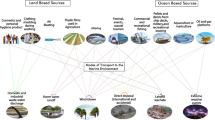Abstract
The bioavailability of fluoranthene (as a model toxicant) in freshwater sediment tests with Chironomus riparius was investigated in relation to the partitioning of the chemical between water and sediment. Effects on survival and successful development of newly hatched larvae through to adult emergence were measured over a range of sediment concentrations. Radiolabelled fluoranthene was employed to enable sediment, aqueous and tissue concentrations to be determined. A significant effect on emergence was obtained at a measured sediment concentration of 80 mg kg-1 (dry weight). The measured concentration in the overlying water was 88 μg l-1. Although effects at 170 mg kg-1 (dry weight) were more severe, the measured concentration in the overlying water was similar (89 μg l-1), probably reflecting the approach towards the solubility limit. Bioaccumulation of fluoranthene, determined by analysis of emerging adults, was approximately proportional to the sediment concentration. Although the aqueous phase concentration appeared to be the principal factor controlling bioavailability, the increasing toxicity, when water concentrations had reached a plateau, suggested that other mechanisms may also be involved. Different sediment spiking procedures resulted in broadly similar partitioning of the chemical between the sediment and the overlying water. There were only minor differences in toxicity between the procedures, two of which allowed the carrier solvent used for spiking to be eliminated before addition of the test organisms. It was concluded that, for most purposes, all four procedures were equally acceptable, and by retaining a flexible approach, even for standardised regulatory tests, spiking procedures may be tailored to the physico-chemical properties of the test material.
Similar content being viewed by others
References
ASTM (American Society for Testing and Materials), 1994a. Standard Guide for Conducting Sediment Toxicity Tests with Freshwater Invertebrates E 1383-94. In: Annual Book of ASTM Standards. Vol. 11.04. pp. 1196–1225. ASTM, Philadelphia.
ASTM (American Society for Testing and Materials), 1994b. Standard Guide for Conducting Acute Toxicity Tests with Fishes, Macroinvertebrates, and Amphibians. E 729-94. In: Annual Book of ASTM Standards. Vol. 11.04. pp. 480–499. ASTM, Philadelphia.
BarrettK. L. & G. P.Dohmen, 1992. A proposed test method for the assessment of pesticide formulation impact on the sediment dwelling larvae of the midge, Chironomus riparius. In: The British Crop Protection Council (eds), Brighton Crop Protection Conference-Pests and Diseases 2. pp. 760–774. The Lavenham Press Limited, Suffolk, U.K.
DunnettC. W., 1964. New tables for multiple comparisons with a control. Biometrics. 20: 482–491.
DiToroD. M., C. S.Zarba, D. J.Hansen, W. J.Berry, R. C.Swartz, C. E.Cowan, S. P.Pavlou, H. E.Allen, N. A.Thomas & P. R.Paquin, 1991. Technical basis for establishing sediment quality criteria for nonionic organic chemicals using equilibrium partitioning. Environmental Toxicology and Chemistry 10: 1541–1583.
FinneyD. J., 1971. Probit Analysis. Third edition. Cambridge University Press, Cambridge, 333 pp.
HillI. R., P.Matthiessen & F.Heimbach (eds), 1993. Guidance Document on Sediment Toxicity Tests and Bioassays for Freshwater and Marine Environments. SETAC-Europe, 105 pp.
IngersollC. G. & NelsonM. K., 1990. Testing sediment toxicity with Hyalella azteca (Amphipoda) and Chironomus riparius (Diptera). In: ASTM STP 1096 13th Symposium on Aquatic Toxicology and Risk Assessment. pp. 93–109. ASTM Philadelphia.
LitchfieldJ. T., 1949. A method for rapid graphic solution of time-percent effect curves. Journal of Pharmacology and Experimental Therapeutics 97: 399–408.
McCahonC. P. & D.Pascoe, 1988. Culture techniques for three freshwater macroinvertebrate species and their use in toxicity tests. Chemosphere 17(12): 2471–2480.
SuedelB. C., J. H.RodgersJr. & P. A.Clifford, 1993. Bioavailability of fluoranthene in freshwater sediment toxicity tests. Environmental Toxicology and Chemistry 12: 155–165.
SwartzR. C., D. W.Schultts, T. H.Dewitt, G. R.Ditsworth & J. A.Lamberson, 1990. Toxicity of fluoranthene in sediment to marine amphipods: a test of the equilibrium partitioning approach to sediment quality criteria. Environmental Toxicology and Chemistry 9: 1071–1080.
USEPA (United States Environmental Protection Agency), 1993. Methods for Measuring the Acute Toxicity of Effluents and Receiving Waters to Freshwater and Marine Organisms. Fourth edition. EPA-600/4-90/027F, Cincinnati, OH, 293 pp.
Author information
Authors and Affiliations
Rights and permissions
About this article
Cite this article
Stewart, K.M., Thompson, R.S. Fluoranthene as a model toxicant in sediment studies with Chironomus riparius . Journal of Aquatic Ecosystem Health 4, 231–238 (1995). https://doi.org/10.1007/BF00118003
Received:
Accepted:
Issue Date:
DOI: https://doi.org/10.1007/BF00118003




